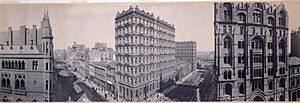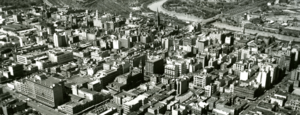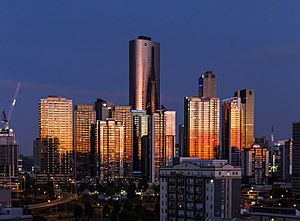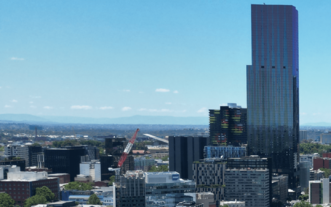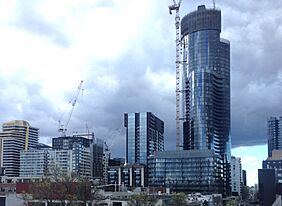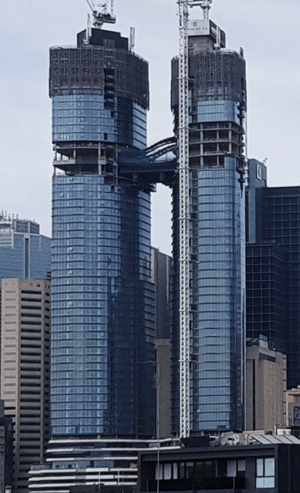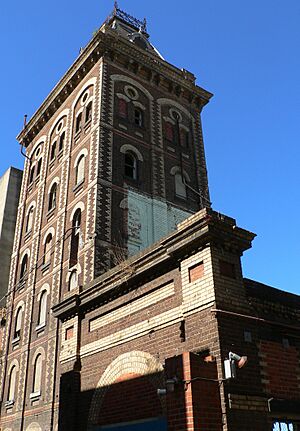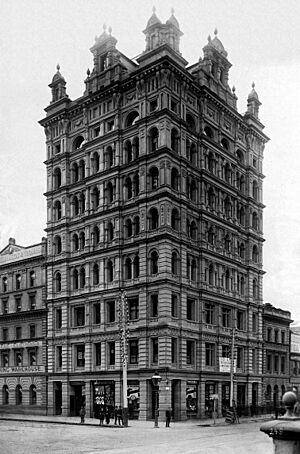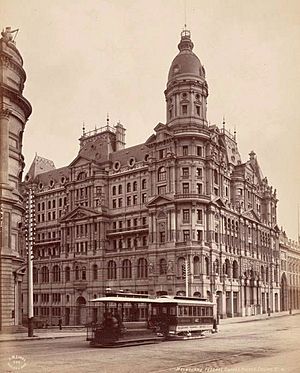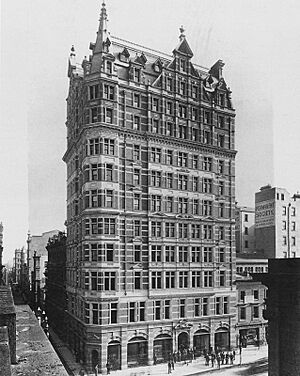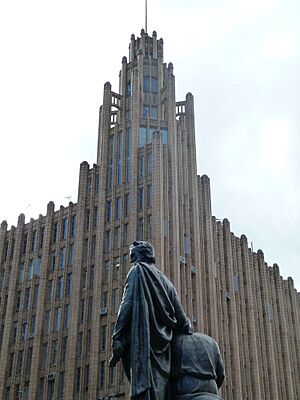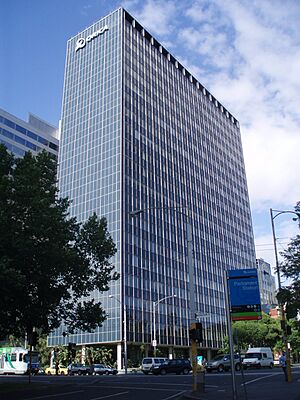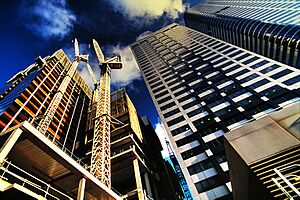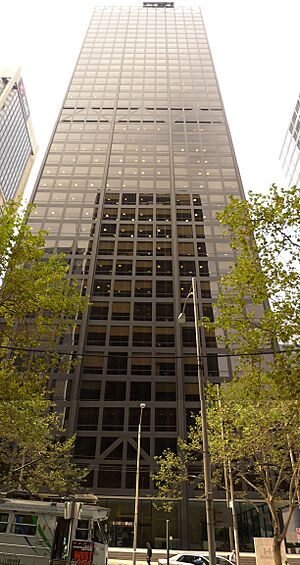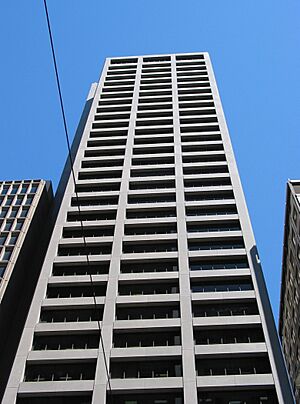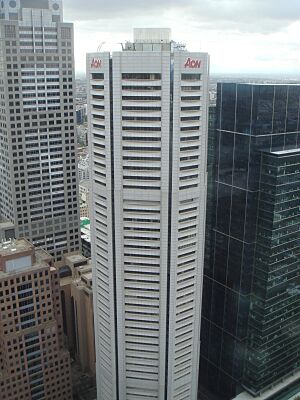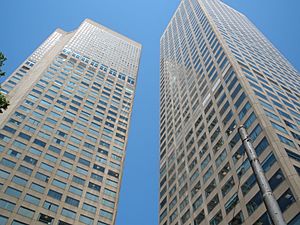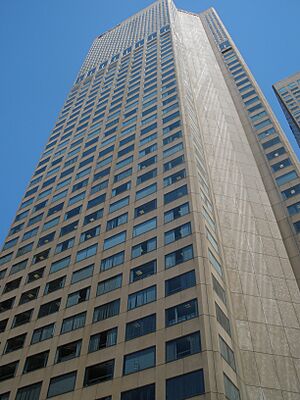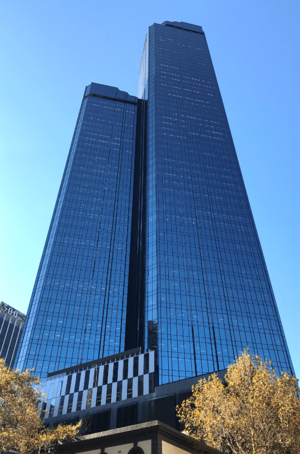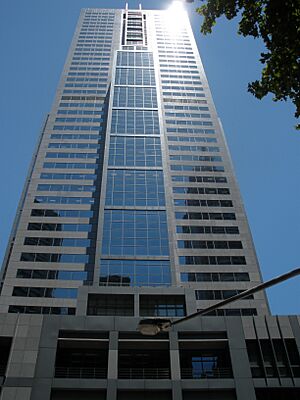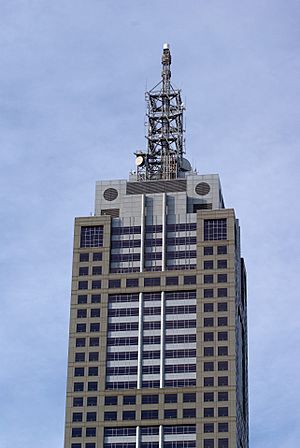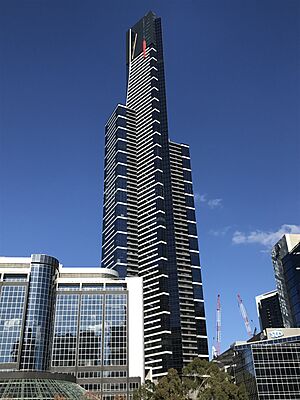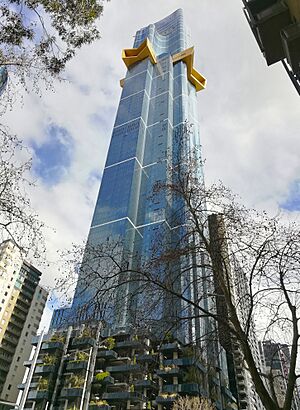List of tallest buildings in Melbourne facts for kids

Quick facts for kids Tall buildings in Melbourne |
|
|---|---|
| Lua error in Module:Wikidata at line 70: attempt to index field 'wikibase' (a nil value). | |
| Tallest building | Australia 108 (2020) |
| Tallest building height | 316.7 m (1,039 ft) |
| First 150 m+ building | 140 William Street (1972) |
| Buildings above 100 m | 153 (2025) |
| Buildings above 150 m | 77 (2025) |
| Buildings above 200 m | 29 (2025) |
| Buildings above 300 m | 1 |
Melbourne is a city with many tall buildings! It has about 758 completed high-rise buildings. Out of these, 77 are considered "skyscrapers." A skyscraper is a building that is at least 150 meters (about 492 feet) tall. Melbourne has more skyscrapers than any other city in Australia.
Melbourne's skyline is the tallest in the Oceania region. It ranks as the 24th tallest in the world based on the number of completed skyscrapers. Five of the ten tallest buildings in Australia are in Melbourne. The city has often had the tallest building in Australia, especially when measured to its roof or highest architectural point.
As of 2025, the tallest building in Melbourne is Australia 108. It has 100 floors and stands 317 meters (1,039 feet) tall. It is the second-tallest building in Australia overall, but it is the tallest when measured to its roof.
Most of Melbourne's tallest skyscrapers are found in the City Centre. However, you can also find many tall buildings in other areas like Box Hill, Carlton, Docklands, Southbank, South Melbourne, South Yarra, and St Kilda Road. The City Centre has a special street layout called the Hoddle Grid. It has a lower shopping area in the middle, with tall buildings grouped in the western financial district and another group in the eastern part.
Melbourne has a history of being "first" in Australia for tall buildings. It was one of the first cities in the world to build many tall office buildings, similar to New York City and Chicago. Melbourne's first big skyscraper boom happened between 1888 and 1892. The APA Building, built in 1889, was Australia's first high-rise. Melbourne also had Australia's first modern high-rise after World War II, called ICI House, built in 1958.
From 1986 to 2005, Melbourne had the tallest building in Australia. This included the Rialto Towers (1986–1991), 101 Collins Street (1991), and 120 Collins Street (1991–2005). Since 2006, Melbourne has been home to the second-tallest building in the country: the Eureka Tower (2006–2020) and then Australia 108 (2020–present). These buildings have been the tallest in Australia when measured to their roof, even though Q1 on the Gold Coast is taller overall.
Contents
History of Melbourne's Tall Buildings

Early Skyscrapers (1800s)
In the late 1880s, Melbourne had a "land boom." This led to the building of about a dozen tall buildings with 8 to 10 floors. New technology, like a special water-powered system for lifts, made these taller buildings possible. The APA Building was the tallest, with 12 floors plus a spire. It was Australia's first "skyscraper" and one of the tallest buildings in the world when it was finished in 1889.
Other tall buildings from this time included the Finks Building. Most of these early skyscrapers were torn down in the 1960s and 1970s. The APA Building was sadly demolished in 1981.
Building Limits (1900s)
In 1916, Melbourne set a height limit of 40 meters (about 131 feet) for buildings. This rule was put in place to make sure there was enough light and fresh air on the streets. It also helped prevent too much traffic and kept the city looking neat. This height limit lasted for almost 40 years. Only decorative parts of buildings, like towers, could go above 40 meters. For example, the Manchester Unity Building (built in 1932) reached 64 meters (210 feet) to the top of its tower.
Melbourne was the first Australian city to have a big building boom after World War II, starting in the late 1950s. More than 50 high-rise buildings were built between the 1970s and 1990s. ICI House (1955) was built after getting special permission to be taller than the limit. At 81 meters (266 feet), it was Australia's first modern high-rise. Its design included an open garden area at ground level. This new idea allowed buildings to be taller if they provided public benefits.
In 1972, 140 William Street became Melbourne's first building to go over 150 meters (492 feet), making it the city's first "skyscraper." It was the tallest building for a few years. Later, the Optus Centre (1975) and Nauru House (1977) became the tallest. In 1978, the first of two Collins Place towers opened, reaching 188 meters (617 feet).
By the early 1980s, Melbourne had 6 buildings over 150 meters tall. In 1986, the Rialto Towers became the tallest building in Australia and the Southern Hemisphere, at 251 meters (823 feet). It was the 25th-tallest building in the world at that time. The 1990s brought 9 more buildings over 150 meters, with 5 of them over 200 meters (656 feet). In 1991, 101 Collins Street (260 meters / 853 feet) became the tallest in Australia. It was soon surpassed by 120 Collins Street (266 meters / 873 feet) later that year. This building held the title of tallest in Australia for 14 years.
New Heights (2000s and 2010s)

In the 2000s, over 20 high-rise buildings were completed. This included the Eureka Tower (2006), which became the tallest building in Melbourne. It was also the second-tallest in Australia and the tallest residential building in the world to its roof for a time.
Building activity really picked up in the 2010s. Buildings like Prima Pearl (2014) and Aurora Melbourne Central (2019) were completed, both over 250 meters (820 feet) tall. Melbourne saw a huge boom in skyscraper construction, with 22 skyscrapers built between 2010 and 2019. People even called it the "Manhattanization of Melbourne," meaning it was starting to look like New York City with all its tall buildings.
In 2015, new rules were put in place to control how tall buildings could be in the City Centre and Southbank. These rules aimed to ensure new buildings also provided benefits to the public, like open spaces.
Melbourne Today (2020s)
The 2020s started with the completion of Australia 108. It became the tallest building in Melbourne and the tallest in Australia to its roof in 2020. It was also the first skyscraper in the Southern Hemisphere to have at least 100 floors. Australia 108 is considered a "supertall" skyscraper, meaning it's between 300 and 599 meters (984 and 1,965 feet) tall.
In 2021, 12 new skyscrapers were completed in Melbourne. This was more than ever before! Some of the tallest built in 2021 were West Side Place Tower A and Queens Place North Tower, both over 250 meters (820 feet) tall.
Melbourne continues to grow. Many new skyscrapers are planned or being built. The tallest future project is STH BNK by Beulah. Its first tower will be 354 meters (1,161 feet) tall, making it the tallest building in Melbourne and all of Australia!
Melbourne and Sydney have a friendly rivalry over which city has more skyscrapers. Melbourne has had the most skyscrapers in Australia and Oceania for over 35 years in total.
Melbourne's Building Areas
Melbourne's main city area, the City Centre, has two distinct parts: the east and the west. These are separated by Swanston Street. The tallest buildings on the eastern side are 120 Collins Street and 101 Collins Street. On the western side, you'll find the Rialto Towers, 568 Collins Street, and Bourke Place.
New skylines have also appeared outside the City Centre, especially in Southbank. This area is next to the City Centre and is home to some of Melbourne's tallest buildings, like Australia 108, Eureka Tower, and Prima Pearl.
Other suburbs like South Yarra, St Kilda Road, Carlton, and Docklands each have at least one skyscraper. More skyscrapers are planned or approved for areas like Port Melbourne and South Melbourne.
What Are These Buildings Used For?
Most of Melbourne's skyscrapers built before the 1990s were used as offices. Some exceptions included the Sofitel Hotel (1980) and the Crown Towers (1997), which were hotels. In 2005, the first residential skyscrapers (buildings where people live) started to appear.
By 2010, most skyscrapers (72%) were offices, 12% were homes, 12% were mixed-use (meaning they had different uses like shops and homes), and 4% were hotels. The trend has shifted a lot! By 2020, many more skyscrapers were for homes. Now, about 44% of the city's skyscrapers are residential, 35% are commercial (offices), 18% are mixed-use, 2% are hotels, and 2% are for government use.
Melbourne's Tallest Buildings

Overall Tallest Buildings
Melbourne has 77 skyscrapers that are completed or topped out, standing at least 150 meters (492 feet) tall. This height includes spires and other architectural details, but not antennas.
| Rank | Name (Street address) |
Image | Height (meters) |
Total floors | Built | Purpose | Location |
|---|---|---|---|---|---|---|---|
| 1 | Australia 108 (70 Southbank Boulevard) |
 |
316.7 | 100 | 2020 | Residential | Southbank |
| 2 | Eureka Tower (7 Riverside Quay) |
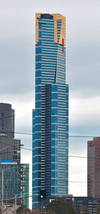 |
297.3 | 91 | 2006 | Residential | Southbank |
| 3 | Aurora Melbourne Central (250 La Trobe Street) |
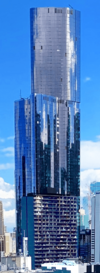 |
270.5 | 85 | 2019 | Mixed use | City Centre |
| 4 | West Side Place Tower A (250 Spencer Street) | 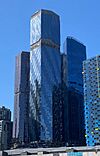 |
268.7 | 81 | 2021 | Mixed use | City Centre |
| 5 | 120 Collins Street | 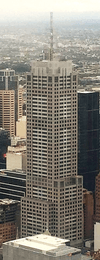 |
266.6 | 52 | 1991 | Office | City Centre |
| 6 | 101 Collins Street | 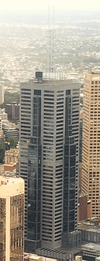 |
260 | 50 | 1991 | Office | City Centre |
| 7 | Prima Pearl (31–49 Queensbridge Square) |
 |
254 | 72 | 2014 | Residential | Southbank |
| 8 | Queens Place North Tower (350 Queen Street) |
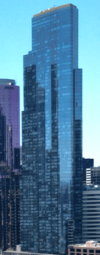 |
252.8 | 79 | 2021 | Residential | City Centre |
| 9 | Rialto Towers (525 Collins Street) |
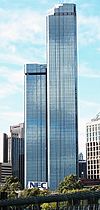 |
251.1 | 63 | 1986 | Office | City Centre |
| 10 | Victoria One (452 Elizabeth Street) |
 |
246.8 | 76 | 2018 | Residential | City Centre |
Tallest Buildings by Area
This table shows the tallest building in each main area of Melbourne.
| Rank | Name | Height | Floors | Area | Completion |
|---|---|---|---|---|---|
| 1 | Australia 108 | 316.7 m | 100 | Southbank | 2020 |
| 2 | Aurora Melbourne Central | 270.5 m | 85 | City Centre | 2019 |
| 3 | Swanston Central | 236.7 m | 71 | Carlton | 2019 |
| 4 | Victoria Police Centre Tower 2 | 180 m | 40 | Docklands | 2020 |
| 5 | Capitol Grand | 178 m | 52 | South Yarra | 2019 |
| 6 | Royal Domain Tower | 162 m | 43 | St Kilda Road | 2005 |
| 7 | Fifty Albert | 98.1 m | 30 | South Melbourne | 2013 |
Tallest Buildings by Use
This table lists the tallest buildings in Melbourne based on what they are used for (office, hotel, home, or mixed-use).
| Rank | Name | Height | Floors | Use | Completion |
|---|---|---|---|---|---|
| 1 | Australia 108 | 316.7 m | 100 | Residential | 2020 |
| 2 | Aurora Melbourne Central | 270.5 m | 85 | Mixed use | 2019 |
| 3 | 120 Collins Street | 266.6 m | 52 | Office | 1991 |
| 4 | Crown Towers | 152.5 m | 43 | Hotel | 1997 |
Skyscrapers Over 200 Meters Tall
Melbourne has 29 skyscrapers that are at least 200 meters (656 feet) tall. This is more than any other city in Australia or Oceania. Most of these (23) are in the City Centre, five are in Southbank, and one is in Carlton.
| List of skyscrapers which stand at least 200 meters in height | ||||
|---|---|---|---|---|
| Rank | Building | Height | Built | Location |
| 1 | Australia 108 | 316.7 m | 2020 | Southbank |
| 2 | Eureka Tower | 297.3 m | 2006 | Southbank |
| 3 | Aurora Melbourne Central | 270.5 m | 2019 | City Centre |
| 4 | West Side Place Tower A | 268.7 m | 2021 | City Centre |
| 5 | 120 Collins Street | 266.6 m | 1991 | City Centre |
| 6 | 101 Collins Street | 260 m | 1991 | City Centre |
| 7 | Prima Pearl | 254 m | 2014 | Southbank |
| 8 | Queens Place North Tower | 252.8 m | 2021 | City Centre |
| 9 | Rialto Towers | 251.1 m | 1986 | City Centre |
| 10 | Victoria One | 246.8 m | 2018 | City Centre |
| 11 | Premier Tower | 245.9 m | 2021 | City Centre |
| 12 | Melbourne Square BLVD | 244 m | 2028 | Southbank |
| 13 | West Side Place Tower D | 239 m | 2023 | City Centre |
| 14 | Swanston Central | 236.7 m | 2019 | Carlton |
| 15 | Shangri-La by the Gardens | 231.7 m | 2023 | City Centre |
| 16 | Melbourne Square Tower 1 | 231 m | 2021 | Southbank |
| 17 | West Side Place Tower C | 230 m | 2023 | City Centre |
| 18 | Vision Apartments | 229 m | 2016 | City Centre |
| 19 | 568 Collins Street | 224 m | 2015 | City Centre |
| Bourke Place | 224 m | 1991 | City Centre | |
| 21 | Sapphire by the Gardens | 218.8 m | 2022 | City Centre |
| 22 | Light House Melbourne | 218 m | 2017 | City Centre |
| Telstra Corporate Centre | 218 m | 1992 | City Centre | |
| 24 | 380 Melbourne | 217.5 m | 2021 | City Centre |
| 25 | 435 Bourke Street | 215 m | 2026 | City Centre |
| 26 | West Side Place Tower B | 211 m | 2021 | City Centre |
| Melbourne Central | 211 m | 1991 | City Centre | |
| 28 | Aspire Melbourne | 210.6 m | 2023 | City Centre |
| 29 | UNO Melbourne | 210 m | 2023 | City Centre |
| 30 | The Queensbridge | 209 m | 2025 | Southbank |
| 31 | Freshwater Place North | 205 m | 2005 | Southbank |
| 32 | EQ Tower | 202 m | 2017 | City Centre |
Melbourne's Skylines
58 skyscrapers completed
3 skyscrapers under construction
15 skyscrapers completed
1 skyscraper under construction
1 skyscraper completed
1 skyscraper completed
1 skyscraper completed
1 skyscraper completed
Future Tall Buildings
This section lists skyscrapers that are currently topped out (meaning their highest point is reached), under construction, approved, or planned for Melbourne.
| Topped out | Under construction | On hold | Approved | Proposed |
| Name | Height (m) |
Floors | Purpose | Area | Estimated completion |
Status |
|---|---|---|---|---|---|---|
| Southbank by Beulah Tower 1 | 366 | 102 | Residential | Southbank | TBA | Approved |
| 25–35 Power Street | 280.3 | 71 | Mixed use | Southbank | TBA | Approved |
| Southbank by Beulah Tower 2 | 273 | 72 | Mixed use | Southbank | TBA | Approved |
| Queens Place South Tower | 251 | 79 | Residential | City Centre | TBA | Approved |
| Atlas Melbourne Setia | 244 | 73 | Residential | City Centre | 2029 | Proposed |
| Melbourne Square BLVD | 244 | 74 | Residential | Southbank | 2028 | Under construction |
| 640 Bourke Street | 234.6 | 68 | Mixed use | City Centre | TBA | Approved |
| 51–65 Clarke Street | 233 | 70 | Residential | Southbank | TBA | Approved |
| 295 City Road | 228 | 70 | Residential | Southbank | TBA | Approved |
| 435 Bourke Street | 215 | 55 | Office | City Centre | 2026 | Under construction |
| 303 La Trobe Street | 213 | 66 | Residential | City Centre | TBA | Approved |
| The Queensbridge | 209 | 66 | Residential | Southbank | 2025 | Under construction |
| 280 Queen Street | 207 | 68 | Residential | City Centre | TBA | Proposed |
| 334–344 City Road | 190 | 58 | Residential | Southbank | TBA | Approved |
| 268–274 City Road | 187 | 55 | Residential | Southbank | TBA | Approved |
| 600 Collins | 182 | 47 | Office | City Centre | 2026 | Under construction |
| 60–82 Johnson Street Tower 1A | 181 | 53 | Residential | South Melbourne | TBA | Approved |
| 60–82 Johnson Street Tower 2B | 181 | 53 | Residential | South Melbourne | TBA | Approved |
| Melbourne Square Tower 5 | 180 | 54 | Hotel | Southbank | TBA | Approved |
| 42 Moray Street | 178 | 56 | Residential | Southbank | 2027 | Under construction |
| Sol Invictus Tower | 178 | 51 | Residential | Southbank | TBA | Proposed |
| 96–102 Franklin Street | 177 | 57 | Residential | City Centre | TBA | Proposed |
| 212–222 La Trobe Street North Tower | 176 | 56 | Residential | City Centre | TBA | Approved |
| Melbourne Square Tower 3 | 175 | 56 | Residential | Southbank | TBA | Approved |
| Melbourne Square Tower 4 | 175 | 56 | Residential | Southbank | TBA | Approved |
| 52–60 Collins Street | 163.1 | 40 | Office | City Centre | TBA | Approved |
| 56-62 Clarendon Street | 159.7 | 49 | Residential | Southbank | TBA | Approved |
| 32 Flinders Street | 158.5 | 41 | Office | City Centre | 2025 | Under construction |
| 57 Haig Street | 155.7 | 47 | Residential | Southbank | TBA | Approved |
| 277-281 Ingles Street | 155 | 51 | Residential | Port Melbourne | TBA | Approved |
| 56-62 Clarendon Street | 155 | 40 | Office | City Centre | TBA | Approved |
| 87–105 Queensbridge Tower 1 | 152.9 | 47 | Mixed use | Southbank | TBA | Proposed |
| 87–105 Queensbridge Tower 2 | 152.9 | 47 | Mixed use | Southbank | TBA | Proposed |
| 85–93 Lorimer Street Tower 1 | 150 | 49 | Residential | Docklands | TBA | Approved |
Timeline of Melbourne's Tallest Buildings
This lists buildings that were once the "tallest building in Melbourne."
| Name | Image | Years as Tallest | Height | Floors |
|---|---|---|---|---|
| Kew Asylum | 1871–1876 | 30 m | 5 | |
| Yorkshire Brewery Tower | 1876–1888 | 34 m | 8 | |
| Fink's Building | 1888 | 43 m | 10 | |
| Federal Coffee Palace | 1888-1890 | 50.292 m | 9 | |
| The Australian Building | 1890–1932 | 53 m | 12 | |
| Manchester Unity Building | 1932–1958 | 64 m | 13 | |
| Orica House | 1958–1962 | 81 m | 20 | |
| CRA Building | 1962–1969 | 99 m | 26 | |
| AMP Square | 1969–1971 | 113.4 m | 28 | |
| Marland House | 1971–1972 | 121 m | 32 | |
| 140 William Street | 1972–1975 | 152.5 m | 41 | |
| Optus Centre | 1975–1977 | 153 m | 34 | |
| Nauru House | 1977–1978 | 182 m | 52 | |
| ANZ Tower at Collins Place | 1978–1986 | 188 m | 56 | |
| Sofitel Hotel at Collins Place | 1980–1986 | 188 m | 50 | |
| Rialto Towers | 1986–1991 | 251.1 m | 63 | |
| 101 Collins Street | 1991 | 260 m | 50 | |
| 120 Collins Street | 1991–2006 | 266.6 m | 52 | |
| Eureka Tower | 2006–2020 | 297.3 m | 91 | |
| Australia 108 | 2020–present | 316.7 m | 100 |
See also
 In Spanish: Anexo:Edificios más altos de Melbourne para niños
In Spanish: Anexo:Edificios más altos de Melbourne para niños
- Architecture of Melbourne
- List of tallest buildings in Australia
- List of tallest buildings in Oceania


